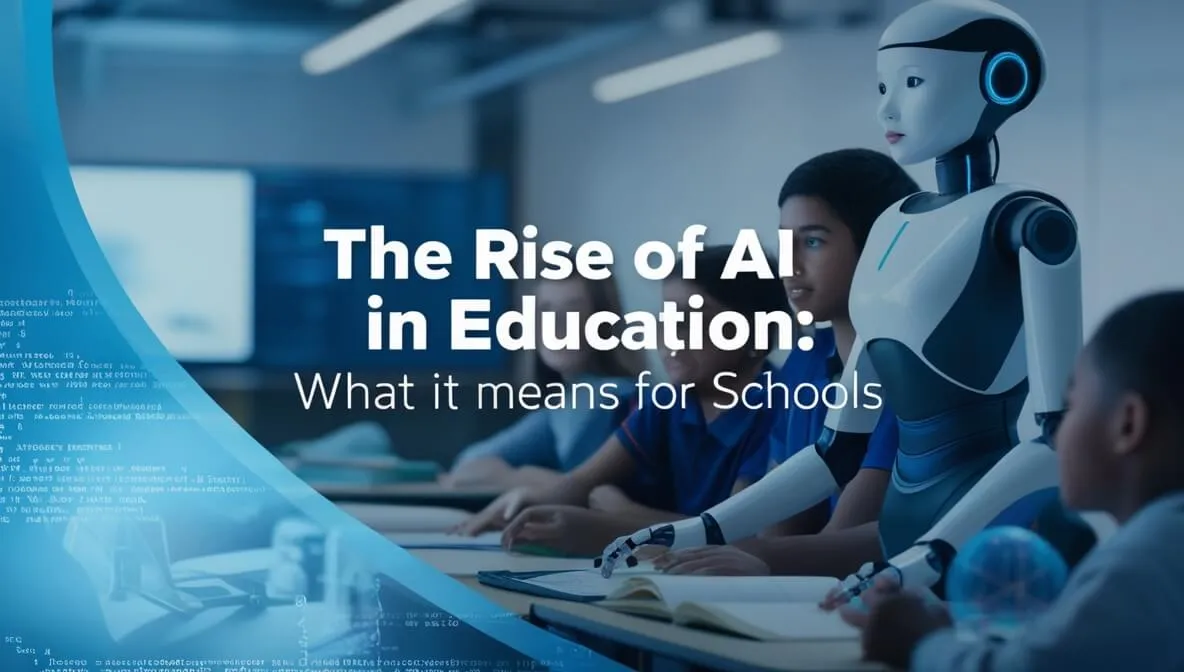Table of Contents
- Introduction
- What is AI in schools?
- Why the rise of AI in schools matters now
- Top AI in schools use cases: Where to start (and why)
- Evidence: Does AI actually improve learning outcomes?
- Designing an ethical AI strategy for schools
- A simple 90‑day pilot plan for AI in schools
- Procurement checklist: Buying AI for schools
- Practical examples: How schools are already using AI in schools
- Costs, ROI, and budgeting for AI in schools
- Risks and how to mitigate them (practical tips)
- Quick comparison table: AI tools for schools (examples)
- Measuring success: KPIs for AI in schools
- Implementation pitfalls to avoid
- Roadmap: 6–18 months to scale AI in schools responsibly
- FAQs (focused on AI in schools and AI in classrooms)
- Conclusion: The rise of AI in schools — a practical verdict
Introduction
AI is no longer a distant idea. It’s in classrooms, admin offices, and teachers’ toolkits. For school leaders, this brings huge opportunity — and real risk. Many schools struggle with limited budgets, complex procurement, and unclear policies. They also face pressure from parents and boards to modernize. This post explains what the rise of AI in schools means. You will learn what works, what to avoid, and how to start a low-risk pilot that delivers quick wins.
Why this matters now
Students already use AI daily. Teachers face rising workloads. Policymakers demand digital literacy. Together, these forces push schools to act. If you don’t plan, your school will react — and that leads to inconsistency, wasted budget, and safety problems.
What you’ll get in this guide
- A clear definition of AI in schools and common use cases.
- Evidence-backed benefits and measurable outcomes.
- Practical steps to implement AI responsibly.
- A checklist and example pilot plan for immediate action.
What is AI in schools?
AI in schools means using artificial intelligence to support teaching, learning, and administrative tasks. Examples include adaptive learning platforms, automated grading, chatbots for student support, and predictive analytics for early intervention. Put simply: AI in schools helps people make smarter decisions faster.
Why the rise of AI in schools matters now
The pace of change is fast. Recent industry reports show large increases in AI adoption across K–12 and higher education. Leaders who prepare now can reduce costs, personalize learning, and free teachers to focus on high-value work. Yet the wrong rollout can harm trust and learning outcomes.
Quick snapshot: What research and reports say
- AI tools are increasingly used by students and faculty, with adoption growing year over year.
- Most educators want guidance and training before wide deployment.
- Privacy, bias, and academic integrity are top concerns.
Top AI in schools use cases: Where to start (and why)
Below are pragmatic, high-impact areas where schools can pilot AI. Each use case lists benefits, risks, and a simple example.
1) Personalized learning and adaptive platforms
Benefits:
- Tailored learning paths increase mastery.
- Real-time feedback accelerates progress.
Risks:
- Algorithmic bias can misplace students.
- Overreliance can reduce teacher judgment.
Example: An adaptive math platform diagnoses gaps and assigns micro-lessons. Teachers get action-ready reports.
2) Assessment, grading, and feedback automation (AI in schools)
Benefits:
- Faster marking saves teacher time.
- Consistent rubric-based grading improves fairness.
Risks:
- Over-trusting automated scores for creative work.
- Academic integrity challenges if students use AI to produce answers.
Example: Use AI to score objective items and draft feedback; human teachers review and finalize.
3) Chatbots and student support (AI in classrooms)
Benefits:
- 24/7 answers for routine queries.
- Quick triage for counseling or attendance issues.
Risks:
- Incomplete answers for complex questions.
- Data privacy if logs are not managed properly.
Example: A school chatbot answers timetable and homework queries and escalates to staff when needed.
4) Administrative automation and operations (AI for teachers/admin)
Benefits:
- Reduced paperwork and scheduling errors.
- Improved resource allocation and budget forecasting.
Risks:
- Process changes require training.
- Integration cost can be high if planned poorly.
Example: AI-driven rostering reduces conflicts and saves admin hours each week.
5) Early-warning and student-success analytics (AI in schools)
Benefits:
- Identify at-risk learners earlier.
- Target interventions and reduce dropout risk.
Risks:
- False positives may stigmatize students.
- Requires high-quality data to work well.
Example: Combine attendance, grades, and engagement signals to flag students who need support.
Evidence: Does AI actually improve learning outcomes?
Short answer: It can — when implemented thoughtfully.
Longer answer: Studies show adaptive systems and immediate feedback improve mastery and engagement. Administrative AI repeatedly reduces time spent on low-value tasks. However, evidence varies by context. Outcomes are best when AI augments teachers, not replaces them.
Designing an ethical AI strategy for schools
Any school adopting AI must plan for safety, fairness, and privacy. Use these pillars as your roadmap.
Pillar 1 — Governance and policy
- Create clear policies for acceptable AI use.
- Define roles: who approves, who trains, who audits.
Pillar 2 — Data privacy and security
- Map the data flows for every AI tool.
- Limit data retention and obtain consent where required.
Pillar 3 — Equity and bias mitigation
- Test models on local student data where possible.
- Include diverse stakeholders in procurement.
Pillar 4 — Transparency and explainability
- Choose vendors that explain decisions and provide logs.
- Offer parents and students plain-language guides.
Pillar 5 — Professional learning and change management
- Train teachers first on pedagogy, then tools.
- Start with small pilots before scaling.

A simple 90‑day pilot plan for AI in schools
Goal: Reduce teacher grading time by 30% and raise formative assessment frequency.
Week 1–2: Needs and readiness
- Survey teachers and IT.
- Choose a single course or grade for the pilot.
Week 3–4: Vendor shortlist and privacy checks
- Shortlist 2–3 tools.
- Run a data privacy impact assessment.
Week 5–8: Setup and training
- Configure the tool and integrate with LMS.
- Train 8–12 teachers.
Week 9–12: Run pilot and measure
- Measure time saved, teacher satisfaction, and student engagement.
- Collect qualitative feedback.
After 90 days: Review and decision
- If metrics meet goals, plan phased rollout.
- If not, iterate or pause.
Procurement checklist: Buying AI for schools
Use this checklist to reduce procurement risk:
• Does the tool minimize data collection? • Is model explainability documented? • Can the tool integrate with your SIS/LMS? • What training and support are included? • What is the total cost of ownership (TCO)?
Practical examples: How schools are already using AI in schools
- Automated marking for multiple-choice and math.
- AI tutors that give extra practice in small chunks.
- Chatbots for attendance and parent communication.
- Predictive analytics to support counselors.
Case study snapshot
A mid-sized urban school introduced an adaptive literacy platform. Results: a 12% lift in reading fluency scores in one term and a 25% reduction in teacher time spent on remedial planning. Key success factor: weekly teacher check-ins and data literacy coaching.
Costs, ROI, and budgeting for AI in schools
AI budgets vary widely. Expect initial costs for licensing, integration, and training. Plan for ongoing costs: updates, monitoring, and additional storage.
How to estimate ROI:
- Quantify teacher hours saved and translate to salary cost saved.
- Estimate improvements in key KPIs (attendance, attainment, retention).
- Factor in risk mitigation and compliance costs.
Risks and how to mitigate them (practical tips)
Risk: Academic integrity breaches
Mitigation: Redesign assessments to test higher-order thinking. Use AI-detection tools and oral defenses.
Risk: Biased or inaccurate predictions
Mitigation: Validate models on local data. Use human review for high-stakes decisions.
Risk: Data breaches
Mitigation: Encrypt data, limit access, and use vendors with strong security certifications.
Quick comparison table: AI tools for schools (examples)
| Tool / Type | Typical Use Case | Notes |
|---|---|---|
| Adaptive learning platforms | Personalized practice, remediation | Good for foundational skills, needs teacher oversight |
| Automated grading tools | MCQs, short answers | Fast turnaround, teachers must review creative work |
| Chatbots / help desks | Timetables, FAQs | Cuts admin queries; escalate complex cases |
| Predictive analytics | Early-warning systems | Valuable but needs quality data |
| Writing-assist / generative tools | Drafting, feedback | Powerful; pair with integrity guidance |
Measuring success: KPIs for AI in schools
Track both educational and operational KPIs.
Educational KPIs
- Mastery rates on formative assessments.
- Growth in reading/math scores.
- Student engagement and time-on-task.
Operational KPIs
- Teacher hours saved per week.
- Reduction in admin processing times.
- Parent and student satisfaction scores.
Implementation pitfalls to avoid
- Buying shiny tech without teacher buy-in.
- Skipping privacy impact assessments.
- Ignoring equity — one-size-fits-all models fail.
- Over-automating and removing teacher judgment.
Roadmap: 6–18 months to scale AI in schools responsibly
- Months 1–3: Pilot and learn
- Run targeted pilots. Measure outcomes.
- Months 4–9: Build capacity
- Train more staff. Standardize policies.
- Months 10–18: Scale
- Integrate tools, automate workflows, and publish impact reports.
FAQs (focused on AI in schools and AI in classrooms)
Is AI in schools safe for student data?
It can be, if you follow privacy best practices. Limit data collection, run impact assessments, and choose vendors with strong security standards.
Will AI replace teachers in schools?
No. AI is a tool. It automates routine tasks and provides insights, but teachers make judgment calls, nurture relationships, and adapt learning to human needs.
How can small schools with limited budgets use AI in classrooms?
Start small. Use low-cost or freemium tools, focus on high-impact areas (like grading or remediation), and partner with districts for shared licenses.
How do we handle cheating with generative AI in schools?
Redesign assessments for critical thinking, require drafts and reflections, and teach students how to use AI ethically.
What training do teachers need for AI in schools?
Teachers need data literacy,
Conclusion: The rise of AI in schools — a practical verdict
AI in schools is here to stay. When used thoughtfully it improves learning, reduces workload, and helps schools operate smarter. But it requires governance, training, and modest pilots. Start small, measure rigorously, and scale with ethics and equity at the center. Embrace AI in schools as a way to amplify great teaching — not replace it.
LegacyEdTech helps schools plan and implement responsible AI pilots. If your school or coaching institute wants a low-risk 90-day pilot that saves teacher time and boosts student outcomes, contact us today to get a free readiness checklist and pilot template.







